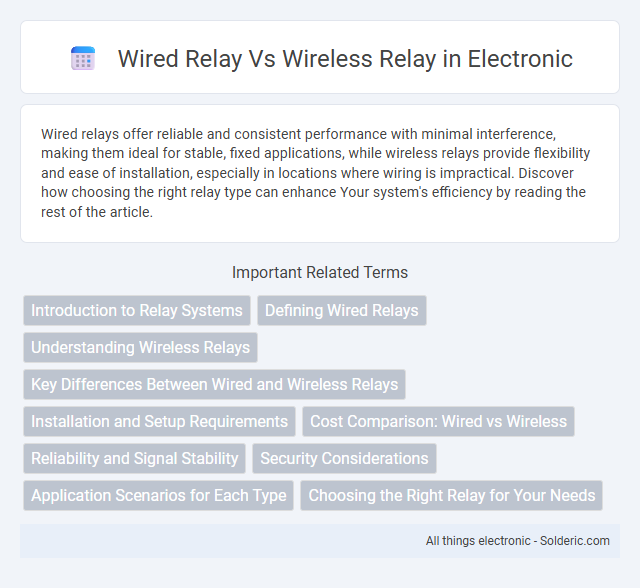Wired relays offer reliable and consistent performance with minimal interference, making them ideal for stable, fixed applications, while wireless relays provide flexibility and ease of installation, especially in locations where wiring is impractical. Discover how choosing the right relay type can enhance Your system's efficiency by reading the rest of the article.
Comparison Table
| Feature | Wired Relay | Wireless Relay |
|---|---|---|
| Connection Type | Physical cable (e.g., Ethernet, copper wires) | Radio waves (Wi-Fi, Bluetooth, Zigbee) |
| Installation | Complex, requires wiring | Simple, no wiring needed |
| Latency | Low latency, stable signal | Variable latency, possible interference |
| Range | Limited to cable length | Several meters up to kilometers, depends on technology |
| Reliability | High reliability, less prone to interference | Subject to wireless interference and signal loss |
| Power Supply | Usually powered via wired connection | May use batteries or external power |
| Maintenance | Requires cable upkeep | Requires battery replacement and updates |
| Security | Physically secure, harder to tamper remotely | Needs encryption to prevent wireless hacking |
| Cost | Higher installation cost due to wiring | Lower initial installation cost |
Introduction to Relay Systems
Wired relay systems utilize physical cables to transmit signals between control units and devices, ensuring stable and low-latency connections crucial for industrial automation and safety-critical applications. Wireless relay systems operate through radio frequency communication, offering flexibility and ease of installation in environments where wiring is impractical or costly. Both relay types serve as essential components in electrical circuits, enabling remote switching and control, but differ significantly in terms of installation, reliability, and application contexts.
Defining Wired Relays
Wired relays are electromechanical switches that use physical electrical wiring to connect and control circuits, ensuring stable and reliable communication between devices. These relays offer reduced interference and consistent signal transmission, making them ideal for industrial automation and safety-critical applications. Their dependence on direct wiring enhances security and minimizes latency compared to wireless relay systems.
Understanding Wireless Relays
Wireless relays operate by transmitting signals through radio frequencies, enabling remote switching without physical connections, which contrasts with wired relays that require direct electrical wiring for activation. These devices are essential in IoT applications, smart home systems, and industrial automation where flexibility and installation ease are critical. Understanding wireless relays involves recognizing their reliance on RF communication protocols like Zigbee, Z-Wave, or Wi-Fi to control electrical circuits remotely and reduce wiring complexity.
Key Differences Between Wired and Wireless Relays
Wired relays offer stable and secure connections through physical cables, ensuring low latency and resistance to electromagnetic interference, ideal for critical industrial applications. Wireless relays provide flexibility with easy installation and remote control capabilities, relying on radio frequency communication subject to signal range and potential interference. Your choice depends on factors like installation environment, reliability requirements, and the need for mobility or fixed connectivity in relay operation.
Installation and Setup Requirements
Wired relay installation demands physical cabling between the relay and control systems, requiring more time and effort for routing wires and ensuring proper connections. Wireless relay setup eliminates the need for extensive wiring, offering greater flexibility and faster deployment, especially in hard-to-reach or large areas. Your choice depends on the environment and the convenience of managing wiring infrastructure versus leveraging wireless communication advantages.
Cost Comparison: Wired vs Wireless
Wired relays generally have lower initial costs due to simpler technology and fewer components, making them cost-effective for fixed installations with minimal interference. Wireless relays incur higher upfront expenses driven by advanced communication modules, batteries, and signal encryption, which can increase maintenance and replacement costs over time. However, wireless solutions significantly reduce labor and infrastructure expenses associated with cable routing and physical installation in complex or expansive environments.
Reliability and Signal Stability
Wired relays offer superior reliability and signal stability due to direct physical connections, minimizing interference and signal loss common in wireless systems. Wireless relays depend on radio frequencies or Wi-Fi signals susceptible to environmental factors such as walls, distance, and electromagnetic interference, which can cause signal drops or delays. For critical applications requiring consistent and uninterrupted performance, wired relays remain the preferred choice given their stable and secure communication pathways.
Security Considerations
Wired relays offer enhanced security due to their physical connections, reducing the risk of unauthorized access and signal interception compared to wireless relays. Wireless relays rely on encrypted communication protocols to prevent hacking, but they remain vulnerable to jamming, spoofing, and man-in-the-middle attacks. Your choice between wired and wireless relays should balance security requirements with installation flexibility and environment constraints.
Application Scenarios for Each Type
Wired relays are ideal for industrial automation and safety-critical systems where reliability and electromagnetic interference resistance are paramount, such as manufacturing plants and power distribution networks. Wireless relays suit home automation, remote monitoring, and IoT applications, providing flexibility in locations where cabling is impractical or costly. Your choice depends on the environment's infrastructure, mobility requirements, and the need for real-time control or data integrity.
Choosing the Right Relay for Your Needs
Choosing the right relay depends on your specific application requirements, as wired relays offer reliable, interference-free connections ideal for stationary systems, while wireless relays provide greater flexibility and ease of installation in dynamic or hard-to-reach environments. Wired relays transmit signals through physical cables, ensuring stable performance and lower latency, whereas wireless relays use radio frequency or Wi-Fi to communicate, enabling remote control and reduced wiring complexity. Assess your priorities such as range, installation constraints, and signal reliability to make an informed choice that best suits your needs.
Wired relay vs wireless relay Infographic

 solderic.com
solderic.com